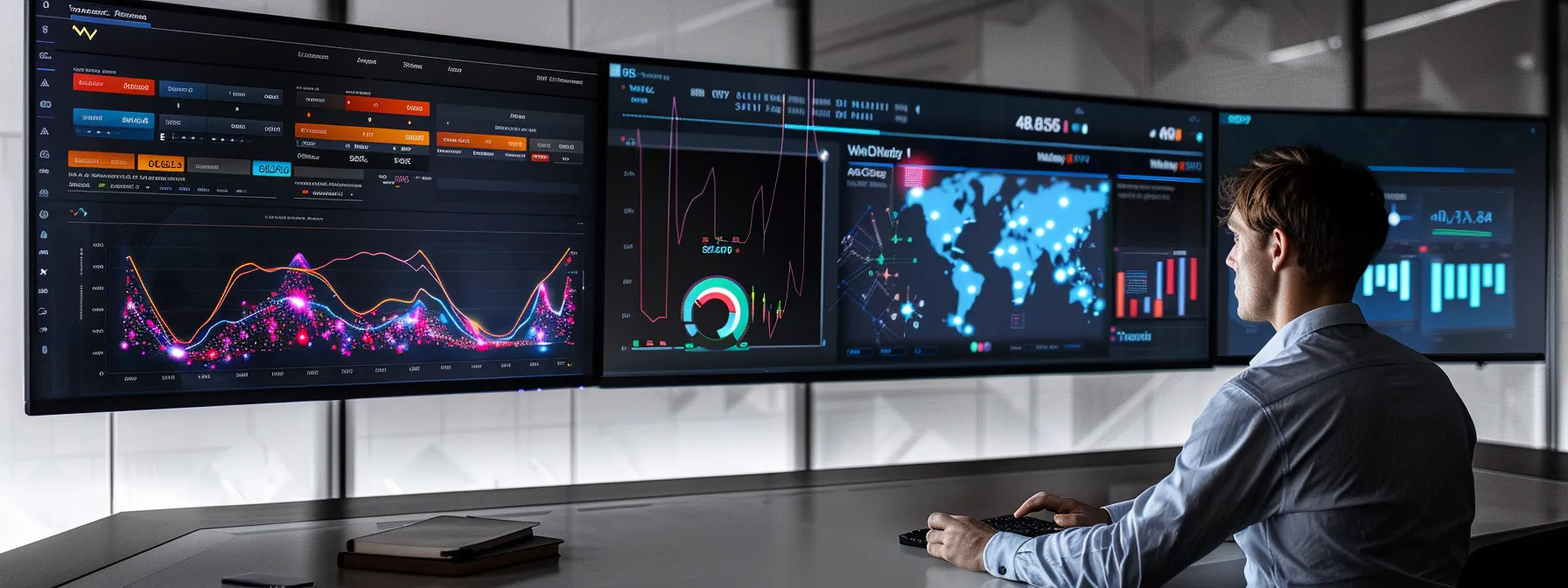What is benchmark?
Are benchmarks confusing business owners seeking operational and efficiency improvements? This article defines benchmark concepts across different settings, explains their importance in business, and outlines the benchmarking process. Readers will learn how various benchmarks apply to business operations and uncover challenges that may arise. With clear examples and actionable insights, the article aims to help businesses overcome common obstacles and make better decisions.
Key Takeaways
- benchmarks guide decision-making across technology, finance, project management, and education
- real-time data processing improves performance evaluation across various sectors
- structured data analysis enhances system efficiency for more informed choices
- continuous benchmark reviews help adapt operational standards to market changes
 Define the Concept of Benchmark in Various Contexts
Define the Concept of Benchmark in Various Contexts
The article covers how benchmarks guide technology comparisons using intel core and ryzen processors, support finance and investment evaluations, and inform project planning. Topics also include benchmarking in educational settings and assessing deep learning super sampling performance for computer systems and android devices, offering practical insights for each area.
Explain How Benchmarks Are Used in Technology
Benchmarks in technology assess performance aspects such as graphics quality and shader efficiency by testing desktop computer systems and devices operating on ios platforms. The evaluations often involve comparing the power of processors like nvidia rtx and other components, ensuring that devices meet specific performance criteria for everyday use.
Technology experts rely on benchmarks to diagnose critical issues and validate system readiness in real-world applications. These procedures provide actionable insights, enabling decision-makers to choose optimal components that enhance user experiences and maximize overall system performance.
Discuss Benchmarks in Finance and Investment
Finance professionals use benchmarks to evaluate investment performance and compare portfolios, often integrating technology such as pci express systems to process and analyze data efficiently. This approach enables decision-makers to assess market trends, identify key hubs of economic activity, and compare performance against a set standard while ensuring that the latest windows of financial data and devices are incorporated effectively.
Benchmarks in finance serve as reliable measures to gauge risk, return, and market stability, offering practical insights into investment strategies. The process relies on advanced technology to connect various devices, integrating pci express capabilities and designated hub systems to compile comprehensive data, which supports accurate evaluations consistent with industry standards.
Illustrate the Role of Benchmarks in Project Management
Project management benchmarks help identify performance gaps by analyzing data and establishing clear benchmarks that ensure all project tasks align with predefined standards. These benchmarks are particularly useful when evaluating a system’s processing thread efficiency and capabilities within environments that use metal and vulkan technologies, offering actionable insights for teams managing mobile device projects.
The structured evaluation process guides project managers in assessing system performance and aligning project deliverables with performance benchmarks. The use of these performance measures, combined with real-time data analysis, supports informed decision-making and allows teams to address project challenges effectively while maintaining a focus on reliable thread management and optimal performance.
Describe Benchmarks in Educational Settings
Educational benchmarks support stakeholders in gauging academic progress and refining learning strategies through clear standards. They serve as a gold standard for evaluating educational software performance, ensuring that tools like radeon-enhanced displays meet optimal frame rate requirements while providing timely feedback on student progress.
When applied in educational settings, benchmarks offer a structured method to assess both teaching methods and technological integration:
Explore the Importance of Benchmarking in Business

This section identifies key advantages ofimplementing benchmarks, analyzes how benchmarks drive performance improvement, and assesses their impact on strategic planning. It features practical case studies showcasing effective benchmarking practices in areas such as automation, marketing, overclocking, debit card technology, and management, setting a foundation for detailed discussion in the subsequent topics.
Identify Key Advantages of Implementing Benchmarks
Implementing benchmarks offers clear advantages by establishing measurable and reliable standards that drive continuous improvement. Experts consider benchmarks a strategic tool, whether assessing performance on a steel frame server, refining workstation output, or evaluating software developed in the english language, thereby ensuring products meet rigorous quality standards across different language environments.
Businesses gain actionable insights through systematic benchmarking, which helps in pinpointing gaps and fostering innovative approaches to meet market demands. This process enables decision-makers to align operational practices with industry best practices, ensuring that each aspect—from workstation efficiency to server reliability—is monitored and optimized using precise language and structured analysis.
Analyze How Benchmarks Drive Performance Improvement
Industry specialists observe that benchmarks drive performance improvement by enabling a transparent evaluation of processes and technologies, such as those found in systems integrating a credit card payment solution or api-based services. By analyzing performance data, decision-makers gain insights that encourage learning and iterative upgrades, contributing to a more efficient operational framework.
Experts emphasize that clear benchmarking criteria pave the way for identifying critical enhancements in environments using components like qualcomm snapdragon processors. This approach acts as an elevator for operational standards, offering a structured method to pinpoint inefficiencies and implement solutions that deliver measurable performance upgrades.
Assess the Impact of Benchmarks on Strategic Planning
The strategic planning process benefits from benchmarking practices that align business operations with standardized criteria. This approach enables experts to explore performance gaps, utilizing metrics such as cpu efficiency to guide decisions and foster a community of knowledge exchange:
- Identifying performance benchmarks
- Monitoring operational standards
- Optimizing resources for better outcomes
Business leaders shop for solutions that incorporate effective benchmarking, translating data-driven insights into actionable strategic plans. Clearly defined benchmarks support informed decision-making and empower organizations to explore market opportunities while reducing risks in competitive environments.
Highlight Case Studies Showcasing Successful Benchmarking Practices
Recent case studies highlight how businesses improved operational efficiency using practical benchmarking methods, featuring insights from benchmark online assessments that involve intel core ultra systems and benchmark cpu evaluations. These studies offer a clear link between precise performance measurements and strategic planning by presenting actionable info that helps decision-makers pinpoint areas for improvement.
One case study, in particular, demonstrates the effective use of benchmark cpu tests to optimize hardware performance in a fast-paced business setting, supported by intel core ultra performance metrics. This example provides useful info and creates a meaningful link with real-world implementation, proving that systematic benchmarking can transform routine operational practices into measurable successes.
Different Types of Benchmarks and Their Applications

Clear distinctions exist in benchmarking, starting with absolute versus relative measures and internal versus external comparisons. The discussion highlights process, performance, and maturity benchmarks through practical examples like the i7 6700 benchmark, bench gpu, benchmark cpu notebook, benchmark mobile cpu, and benchmark ryzen, offering focused insights for professionals analyzing system and component performance.
Clarify Absolute Versus Relative Benchmarks
Absolute benchmarks measure specific parameters against fixed standards, while relative benchmarks compare current performance relative to other systems, offering insight into areas such as a cpu gaming benchmark or mainboard benchmark performance. This differentiation helps technical teams assess metrics like pass mark cpu scores and optimize system configurations based on fire strike evaluations.
Relative benchmarks provide a comparison against similar systems, making them ideal for scenarios such as bourbon benchmark reviews, where variations in hardware performance are highlighted. These measurement techniques allow businesses to objectively evaluate system efficiency, aligning technical specifications with real-world performance requirements.
Differentiate Between Internal and External Benchmarks
Internal benchmarks focus on setting performance standards within the organization, enabling teams to compare current outputs against specific goals derived from historical data, such as evaluating an apple m1 system’s processing speeds or the clarity of an 1080p display output. This approach supports detailed image assessments and refines strategies in environments like retail, where consistency in music playback and device performance is crucial.
External benchmarks, in contrast, rely on data from industry-wide studies to position a system’s capabilities against those of competitors, enabling a well-rounded view of current market standards including apple m1 performance metrics and image quality measurements. The practice provides actionable insights for improving offerings and harmonizing performance across diverse applications such as music, retail interfaces, and 1080p video display, ensuring businesses meet rigorous quality expectations.
Describe Process, Performance, and Maturity Benchmarks
Process benchmarks focus on evaluating workflows and operational efficiencies within various systems, including linux-based platforms. They provide clear, actionable data to guide improvements in internal procedures and resource management.
Performance benchmarks measure system speeds and task handling abilities, offering insights critical for technicians working on linux environments:
- Assessment of processing speeds
- Analysis of task efficiency
- Evaluation of resource allocation
Maturity benchmarks, on the other hand, assess the evolution of system capabilities over time, ensuring that organizations continuously improve their technology infrastructure.
Understand the Benchmarking Process
The process begins with defining clear steps for effective benchmarking. It involves thorough data collection and analysis, establishing realistic targets, and scheduling regular reviews to adjust practices steadily. This structured approach guides teams in aligning operational standards with measurable outcomes and supports continuous improvement across technical evaluations and project performance.
Outline the Steps Involved in Effective Benchmarking
The first step in effective benchmarking involves setting distinct objectives and gathering precise performance data from relevant systems and devices. This initial stage lays a foundation for reliable evaluations by ensuring that all necessary information is collected accurately and promptly:
- Establish clear performance goals
- Collect comprehensive data samples
- Verify data accuracy and consistency
Next, experts perform comparative analyses against predefined standards while carrying out systematic reviews to locate any gaps. This careful examination supports informed decision-making and streamlines the process of advancing operational performance.
Discuss the Role of Data Collection and Analysis
The role of data collection is critical in laying a solid foundation for the benchmarking process, as it gathers accurate metrics directly from systems and devices under evaluation:
Data analysis transforms raw metrics into actionable insights, guiding experts in comparing system performance against established benchmarks and refining operational standards. This systematic approach aids organizations in addressing critical pain points and devising strategies for sustained performance improvement.
Explain How to Set Realistic Benchmark Targets
Realistic benchmark targets are set by defining clear, measurable objectives that reflect current system performance levels and desired improvements. Experts suggest that aligning targets with historical data and industry standards guides technical teams in creating actionable goals.
Teams achieve this by following a systematic approach that includes setting objectives, gathering accurate data, and verifying metrics before establishing targets:
- Define performance goals
- Collect comprehensive data samples
- Analyze and verify collected metrics
This method ensures benchmarks are both pragmatic and effective for ongoing operational improvements.
Detail the Importance of Continuous Review and Adjustment
Continuous review and adjustment form a critical part of benchmarking as they ensure that performance goals remain aligned with changing operational demands. Regular reassessment of collected data and benchmarks drives necessary modifications that benefit efficiency and system reliability.
Ongoing evaluations optimize resource utilization and confirm that established criteria consistently reflect real-world conditions:
- Establish measurable performance targets
- Collect and analyze updated data
- Revise benchmarks to meet operational needs
This proactive approach minimizes performance discrepancies and supports strategic decision-making.
Examine Challenges and Limitations of Benchmarks

Experts note common pitfalls in benchmark applications and recognize that market fluctuations affect accuracy. They also assess how relevance varies across sectors. This analysis sets the stage for a more detailed discussion on pitfalls, market influences, and sector comparisons, offering practical insights for informed decision-making.
Identify Common Pitfalls When Using Benchmarks
Organizations often face pitfalls when using benchmarks, such as relying too heavily on limited data sets or fixed performance measurements that do not capture evolving conditions. Experts highlight common issues including data misinterpretation, sample bias, and non-comparative metrics:
- Overreliance on outdated data
- Misinterpretation of results
- Failure in accounting for contextual differences
Business owners frequently encounter challenges when benchmarks do not reflect actual operational environments, leading to misplaced priorities and ineffective strategies. Technical specialists advise reviewing benchmark criteria regularly and ensuring data accuracy to mitigate risks and strengthen decision-making processes.
Discuss the Impact of Market Changes on Benchmarks
Market changes directly affect benchmark outcomes by altering real-world conditions and altering the performance expectations for devices and systems. Business owners and technical experts notice that fluctuations in technology adoption and economic trends can shift evaluation standards, leading to adjustments in the benchmark criteria used to assess office equipment performance and system efficiency.
Changes in market conditions often require organizations to revisit and update their benchmark parameters to reflect current operational realities. Decision-makers find that analyzing updated market data and performance indicators provides practical insights that support effective evaluations, ensuring that benchmarks remain a reliable tool for guiding improvements in technology and business strategies.
Analyze the Relevance of Benchmarks Across Different Sectors
Benchmarks provide valuable insights across sectors by measuring performance against established standards, which helps professionals identify gaps and optimize systems efficiently. Business owners and IT experts use these measurements to make informed decisions, ensuring that operational strategies remain aligned with both technical and commercial needs:
Industry specialists note that benchmark relevance often varies by sector, highlighting the need for tailored evaluation methods. Practical examples from sectors such as managed IT services and equipment leasing demonstrate that benchmarks serve as an essential tool for maintaining precise quality measures and operational excellence.
Future Trends in Benchmarking
Technology drives new directions in benchmarking as enhanced data analysis improves performance assessments. Big data shapes strategies with improved precision and efficiency. Future developments point to innovative methods and refined evaluation techniques that ensure practical and reliable standards. This section covers technology’s role, big data’s influence, and upcoming benchmarking approaches, offering expert insights and actionable steps for better measurement practices.
Explore the Impact of Technology on Benchmarking Practices
Technology continuously advances benchmarking practices by introducing more accurate data analysis and measurement methods. Experts observe that the integration of real-time data processing and cloud computing facilitates quicker adjustments in performance standards for office equipment and IT services, ensuring a more adaptive and responsive evaluation process.
Innovations in machine learning and automation further streamline the benchmarking process by reducing manual intervention and enhancing accuracy. This approach provides businesses with actionable insights that aid in optimizing resources and improving overall system efficiency, making it easier to maintain optimal performance standards in today’s challenging business landscape.
Discuss How Big Data Influences Benchmarking Strategies
Big data plays a significant role in advancing benchmarking strategies by enabling rapid data collection and refined performance analysis. Its extensive metrics improve the identification of operational gaps and support data-driven decision-making:
Big data influences benchmarking strategies by supplying comprehensive performance data and facilitating continuous monitoring. This approach equips technical teams with actionable insights that improve system evaluations and support efficient resource management for IT services and office equipment solutions.
Predict Future Developments in Benchmarking Methodologies
Technical experts predict that future benchmarking methodologies will integrate real-time analytics and machine learning to improve system evaluations, enabling businesses to swiftly adjust operating standards. This evolution aims to deliver precise performance metrics that guide decision-makers in optimizing IT services and office equipment solutions:
- Integration of real-time analytics
- Adoption of machine learning for improved metrics
- Enhanced system evaluations through data precision
Industry professionals anticipate that automation and advanced data processing will further refine benchmarking procedures, making evaluations more accurate and systematic. These developments provide actionable insights that help streamline operational performance and support informed decisions for managed IT services and office equipment leasing.
Conclusion
Understanding benchmarks helps organizations gauge performance across technology, finance, project management, and education. It offers a clear framework for comparing different systems by establishing measurable and reliable standards. Business leaders and technical experts use these metrics to drive operational improvements and strategic planning. This understanding empowers decision-makers to set realistic targets and adjust practices to meet evolving operational requirements.
What is benchmark in different business settings?
A benchmark in business defines a reference standard to measure performance, productivity, or quality, guiding improvements across managed IT services, cybersecurity, and office equipment sectors, ensuring operational strategies meet expected business outcomes.
How does benchmarking support business strategies?
Benchmarking offers a systematic method to evaluate performance levels, measure efficiency, and pinpoint refined opportunities for improvement, effectively supporting strategic planning for office equipment leasing, IT services, and integrated cybersecurity solutions.
What types of benchmarks are commonly used?
Common benchmarks include key performance indicators measuring uptime, overall equipment effectiveness, cost per page, and throughput. These metrics help businesses evaluate office equipment performance and IT system efficiency in managed cybersecurity and IT services.
What steps define the benchmarking process?
Benchmarking follows a clear process: defining objectives, collecting reliable data, assessing industry standards, comparing performance metrics, identifying gaps, and establishing improvement targets.
What challenges impact benchmark accuracy?
Variability in hardware performance, network interference, and software mismatches impact benchmark accuracy. Unstable test environments and inconsistent measurement standards further complicate precise evaluations of copiers and managed IT equipment.




 Define the Concept of Benchmark in Various Contexts
Define the Concept of Benchmark in Various Contexts






